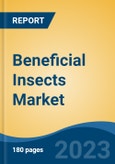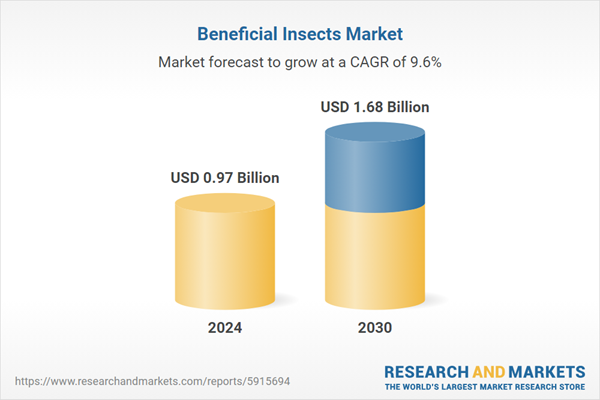Free Webex Call
The Beneficial Insects Market was valued at USD 0.97 Billion in 2024, and is expected to reach USD 1.68 Billion by 2030, rising at a CAGR of 9.64%. In the intricate tapestry of the natural world, insects play a pivotal role in maintaining the delicate balance of ecosystems. While some may be perceived as pests, a myriad of insects prove to be invaluable allies in sustaining biodiversity and promoting ecological harmony. These beneficial insects contribute to agriculture, pest control, and overall environmental health. Their multifaceted roles make them indispensable to human societies and the broader web of life. Speak directly to the analyst to clarify any post sales queries you may have.
10% Free customizationThis report comes with 10% free customization, enabling you to add data that meets your specific business needs.
In this exploration, we delve into the realm of beneficial insects, uncovering the significance of their presence and the positive impact they have on our planet. Among the unsung heroes of the insect world are pollinators such as bees, butterflies, and beetles. These industrious creatures facilitate the reproduction of flowering plants, ensuring the production of fruits, vegetables, and seeds.
The profound interconnectedness between plants and pollinators highlights the crucial role these insects play in agriculture and food production. Additionally, predatory insects, such as ladybugs, lacewings, and parasitic wasps, emerge as natural guardians of crops by preying on harmful pests. This natural pest control mechanism not only reduces the need for chemical interventions but also fosters sustainable farming practices. The symbiotic relationships between plants and insects underscore the intricate dance of life on Earth, where each partner contributes to the well-being of the other.
Key Market Drivers
Rising Demand for Organic Farming
The global agricultural landscape is undergoing a significant transformation as consumers and farmers alike increasingly recognize the importance of sustainable and environmentally friendly farming practices. One of the key contributors to this shift is the rising demand for organic farming, which, in turn, is bolstering the growth of the Beneficial Insects Market. Organic farming is gaining traction worldwide as consumers become more conscious of the environmental and health implications of conventional farming methods. The use of synthetic pesticides and fertilizers in traditional agriculture has raised concerns about soil and water pollution, as well as potential health risks associated with residual chemical residues in food products.In contrast, organic farming emphasizes natural and holistic approaches to crop cultivation, avoiding the use of synthetic chemicals. One of the essential components of organic farming is the integration of beneficial insects into agricultural ecosystems. These insects play a crucial role in pest management, acting as natural predators to control the population of harmful pests that can damage crops. Ladybugs, parasitic wasps, predatory beetles, and nematodes are among the commonly used beneficial insects in organic farming. The Beneficial Insects Market has experienced a surge in growth as farmers transition to organic practices.
Integrated Pest Management (IPM) strategies, which involve the introduction of beneficial insects alongside other eco-friendly pest control methods, have become a cornerstone of sustainable agriculture. This approach minimizes the reliance on chemical pesticides, promoting a healthier and more balanced ecosystem within farming environments. The demand for beneficial insects is further fueled by the increasing awareness of the negative impacts associated with chemical pesticides.
Pesticide residues on crops, soil degradation, and the development of pesticide-resistant pests are some of the concerns that have prompted farmers to seek alternative pest control methods. Beneficial insects offer an effective and environmentally friendly solution, contributing to the overall health of the agricultural ecosystem. Governments and regulatory bodies are also playing a role in supporting the transition to organic farming and the use of beneficial insects. Many countries are implementing policies and incentives to encourage sustainable agricultural practices, recognizing the long-term benefits of reducing the environmental footprint of farming activities.
Key Market Challenges
Conventional Practices
The global Beneficial Insects Market faces significant challenges stemming from entrenched conventional farming practices that have long relied on chemical pesticides. While the shift towards more sustainable agriculture is gaining momentum, the inertia of traditional methods poses obstacles to the widespread adoption and success of beneficial insects in pest management. One of the primary challenges lies in the deeply ingrained use of chemical pesticides in conventional farming. Many farmers have become accustomed to the convenience and apparent immediacy of these synthetic chemicals in controlling pests. Breaking away from this reliance on pesticides requires a paradigm shift in mindset and practices.Convincing farmers to embrace alternative methods, such as the integration of beneficial insects, is a formidable task, as it involves unlearning established practices and adapting to a more ecologically sensitive approach. The perceived effectiveness of chemical pesticides is a significant barrier. These substances often provide a quick and visible reduction in pest populations, offering a seemingly straightforward solution to farmers. In contrast, the impact of beneficial insects is more gradual and may require a shift in the understanding of pest management timelines. Educating farmers about the long-term benefits of using beneficial insects, such as improved soil health and sustainable pest control, is essential in overcoming this perception challenge.
The compatibility of beneficial insects with existing conventional practices is another hurdle. Conventional agriculture often involves the use of broad-spectrum pesticides that indiscriminately target both harmful and beneficial insects. This can disrupt the delicate balance of ecosystems, making it challenging for beneficial insects to thrive. Integrating these natural predators into environments where chemical residues persist requires careful planning and a phased transition to more sustainable practices. The economic considerations associated with conventional practices can impede the adoption of beneficial insects. Chemical pesticides are often readily available, easy to apply, and perceived as cost-effective in the short term.
On the other hand, the upfront costs of introducing beneficial insects may seem prohibitive to some farmers, especially those operating on tight budgets. Demonstrating the long-term economic benefits, such as reduced input costs and increased crop yields, is crucial in overcoming the economic barriers to adoption. Resistance to change within the agricultural community is a pervasive challenge. Farmers may be hesitant to adopt new practices, fearing potential disruptions to their established routines and uncertainties about the efficacy of alternative methods.
Building trust through comprehensive education, pilot programs, and success stories is vital in overcoming resistance and fostering a culture of innovation and sustainability in agriculture. The competitive landscape of the agricultural input market also poses challenges to the Beneficial Insects Market. The well-established market for chemical pesticides, supported by extensive research, development, and marketing, presents a formidable barrier to entry for alternatives. Government incentives, subsidies, and regulatory support may be necessary to level the playing field and encourage the widespread adoption of beneficial insects.
Key Market Trends
Ease of Management in Controlled Environments
The ease of management in controlled environments is a significant advantage for the use of beneficial insects in agriculture. Controlled environments, such as greenhouses or enclosed agricultural spaces, offer a level of precision and predictability that enhances the effectiveness and efficiency of incorporating beneficial insects into integrated pest management (IPM) strategies. One key aspect contributing to the ease of management in controlled environments is the ability to manipulate and optimize conditions for the beneficial insects. Greenhouses, for example, provide a controlled climate, including temperature, humidity, and light levels, which can be tailored to the specific requirements of the beneficial insect species being utilized.This controlled environment allows for the creation of ideal conditions that promote the reproduction, survival, and activity of beneficial insects, ensuring their maximum efficacy in pest control. In such enclosed settings, the risk of external factors, such as adverse weather conditions, is minimized. Beneficial insects are often susceptible to fluctuations in temperature, wind, and precipitation, which can impact their effectiveness in open-field applications. Controlled environments provide a sheltered space where these external variables can be mitigated, creating a stable and conducive habitat for the beneficial insects to thrive.
Additionally, the ease of management in controlled environments extends to the targeted release and distribution of beneficial insects. Farmers and growers can strategically introduce these natural predators to specific areas within the controlled environment, focusing on areas with known pest issues or potential infestations. This targeted approach allows for a more efficient use of beneficial insects, ensuring that they are concentrated where they are needed most. Monitoring and tracking the population dynamics of beneficial insects are also more straightforward in controlled environments.
Farmers can implement advanced monitoring technologies, such as sensors and cameras, to assess the effectiveness of the beneficial insect population in real-time. This ability to closely observe and quantify the impact of beneficial insects on pest populations enables farmers to make data-driven decisions, adjusting release rates or introducing additional beneficial insects as needed. The ease of management is further enhanced by the reduced likelihood of interference from external factors, such as chemical drift from neighboring fields. In open-field agriculture, the use of chemical pesticides in nearby areas can inadvertently harm beneficial insect populations.
In contrast, controlled environments provide a physical barrier that minimizes the risk of external pesticide exposure, allowing beneficial insects to carry out their pest control functions without disruption. Integrated technology solutions also play a role in the ease of management within controlled environments. Automated systems for releasing beneficial insects, monitoring environmental conditions, and collecting data can streamline the entire process. This level of automation not only reduces the labor-intensive nature of managing beneficial insects but also ensures a consistent and optimized approach to pest control.
Key Market Players
- Andermatt Group AG
- Evergreen Growers Supply, LLC
- IPM Laboratories, Inc.
- FAR Inc.
- Organic Control, Inc.
- Eco Bugs India Pvt. Ltd.
- Bioline AgroSciences Ltd
- Biobest Group NV
- BioBee Ltd
- Fagro Limited
- Applied Bionomics Ltd
Report Scope:
In this report, the Global Beneficial Insects Market has been segmented into the following categories, in addition to the industry trends which have also been detailed below:Beneficial Insects Market, By Type:
- Predators
- Parasitoids
- Pathogens
- Pollinators
Beneficial Insects Market, By Application:
- Crop Protection
- Crop Production
Beneficial Insects Market, By Crop Type:
- Fruits & Vegetables
- Flowers & Ornamentals
- Grains & Pulses
Beneficial Insects Market, By Region:
- North America
- United States
- Canada
- Mexico
- Europe
- France
- United Kingdom
- Italy
- Germany
- Spain
- Asia-Pacific
- China
- India
- Japan
- Australia
- South Korea
- South America
- Brazil
- Argentina
- Colombia
- Middle East & Africa
- South Africa
- Saudi Arabia
- UAE
Competitive Landscape
Company Profiles: Detailed analysis of the major companies present in the Global Beneficial Insects Market.Available Customizations:
With the given market data, the publisher offers customizations according to a company's specific needs. The following customization options are available for the report.Company Information
- Detailed analysis and profiling of additional market players (up to five).
This product will be delivered within 1-3 business days.
Table of Contents
1. Product Overview
2. Research Methodology
3. Executive Summary
6. Global Beneficial Insects Market Outlook
7. Asia Pacific Beneficial Insects Market Outlook
8. Europe Beneficial Insects Market Outlook
9. North America Beneficial Insects Market Outlook
10. South America Beneficial Insects Market Outlook
11. Middle East and Africa Beneficial Insects Market Outlook
12. Market Dynamics
13. Market Trends & Developments
15. Competitive Landscape
Companies Mentioned
- Andermatt Group AG
- Evergreen Growers Supply, LLC
- IPM Laboratories, Inc.
- FAR Inc.
- Organic Control, Inc.
- Eco Bugs India Pvt. Ltd.
- Bioline AgroSciences Ltd
- Biobest Group NV
- BioBee Ltd
- Fagro Limited
- Applied Bionomics Ltd
Table Information
| Report Attribute | Details |
|---|---|
| No. of Pages | 183 |
| Published | February 2025 |
| Forecast Period | 2024 - 2030 |
| Estimated Market Value ( USD | $ 0.97 Billion |
| Forecasted Market Value ( USD | $ 1.68 Billion |
| Compound Annual Growth Rate | 9.6% |
| Regions Covered | Global |
| No. of Companies Mentioned | 11 |









